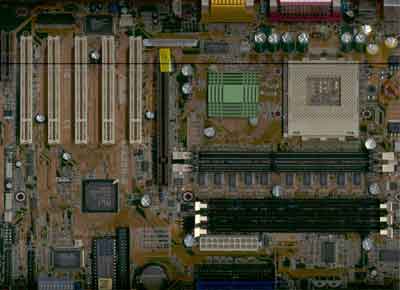VIA KT266A Motherboard Roundup - January 2002
by Mike Andrawes on January 18, 2002 4:48 AM EST- Posted in
- Motherboards
ASUS A7A266-E
|
ASUS A7A266-E |
|
|
CPU
Interface
|
Socket-A
|
|
Chipset
|
ALi
M1647 North Bridge
ALi M1535D+ South Bridge |
|
Form
Factor
|
ATX
|
|
Bus
Speeds
|
100
- 166MHz (in 1MHz increments)
|
|
Core
Voltages Supported
|
1.125
- 1.850V (in 0.025V increments)
|
|
I/O
Voltages Supported
|
Not
Configurable
|
|
DRAM
Voltages Supported
|
2.5 / 2.6 V
|
|
Memory
Slots
|
2
184-pin DDR DIMM Slots
3 168-pin SDR DIMM Slots |
|
Expansion
Slots
|
1
AGP Pro Slot
5 PCI Slots 1 AMR Slot |
|
Onboard
RAID
|
N/A
|
|
Onboard
USB 2.0/IEEE-1394
|
N/A
|
|
Onboard
Audio
|
C-Media
CMI 8738
|
A lot of people were very disappointed about the first version of the ALI MaGiK 1 chipset because of its sub-par performance, and a lot of manufacturers hesitated in putting the chipset on their motherboards. After more revisions of the chipset, the latest version from ALi finally caught up with the KT266A.
ASUS was one of the few manufacturers who did release a board using the original ALi MaGiK 1 chipset with the A7A266. This time around, ASUS released a new revision of the board using the C-stepping of the chipset - calling it the A7A266-E.
In an attempt to capture more marketshare ASUS put in 2 DDR DIMM slots and 3 SDR DIMM slots so you can have more flexibility in memory choice. However, with a maximum of 3GB / 6 rows of memory access, ASUS should have put in 3 DDR DIMM slots, especially when 512MB modules still aren't common yet.
ASUS continues to use their special Medallion 6.00 BIOS for the A7A266-E. It offers reasonable amount of overclocking setups including voltage tweakings for CPU core and memory, but overclocking wasn't as impressive on the board as some other candidates we have seen in this roundup.
The main reason behind this is the lack of 1/6 divider for the PCI bus. In the BIOS, as you increase the FSB speed you can also see the corresponding speed the PCI bus will be running. At 166MHz you can see that the PCI bus is running at 42MHz, which corresponds to a 1/4 divider. Ideally, with a 1/5 divider, the PCI bus will continue to run at 33MHz to maintain system stability.
Moreover, the system does not allow you to run your FSB and memory asynchronously, meaning that you will be pushing your memory as you increase the FSB speed.
On the other hand, the board follows ASUS's tradition and was rock solid throughout all of our tests. The two extra USB connectors give you the options to connect more devices to the system, though ASUS doesn't ship the board with additional USB ports.
The A7A266-E came out a bit later than their KT266A solution, the A7V266-E, and it's clear that the board is not as feature rich as the A7V266-E.











3 Comments
View All Comments
Anonymous User - Monday, September 29, 2003 - link
How do I get my Engine to Memory clock to run synchronous for my Epox 8kha+ boardxrror - Saturday, August 14, 2021 - link
This was such an exciting time in PC hardware. Intel was still trying to cram Rambus down the industry's throat - and obstinately trying to strong arm the mobo makers and force chipset makers to Rambus licensing. We still had VIA, SiS, ULi, and even nVidia in the chipset market, and with AMD's Athlon line still extraordinarily competitive and Intel in full attack they could no longer just consider AMD as a side-show - this was their leverage against Intel and they had to treat Socket A as premium platform.NegativeROG - Wednesday, June 15, 2022 - link
I still have this board. AND, I invested all of a $10,000 inheritance in Rambus RDRAM. I'm smarter now (I hope). But, you are right about exciting times in the PC space. I navigated away from AMD for a bit, but came back, and will stay forever. Team RED!